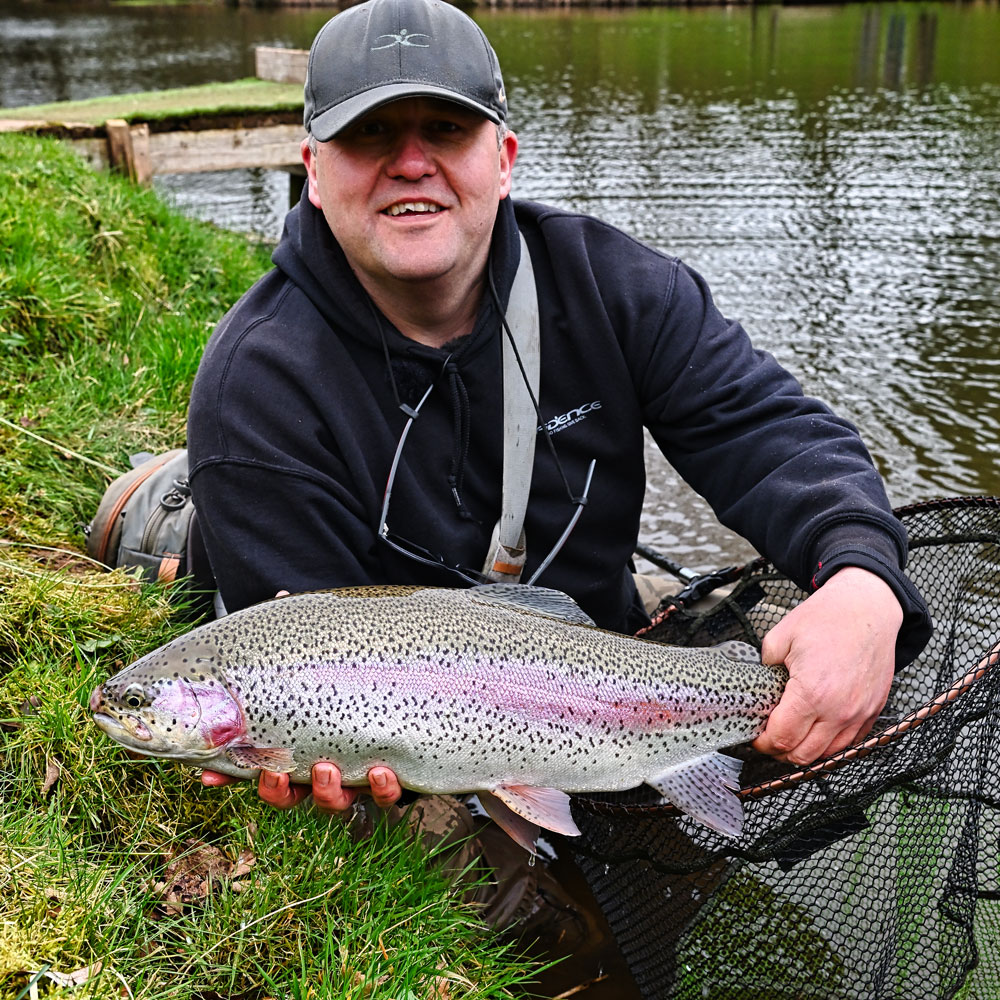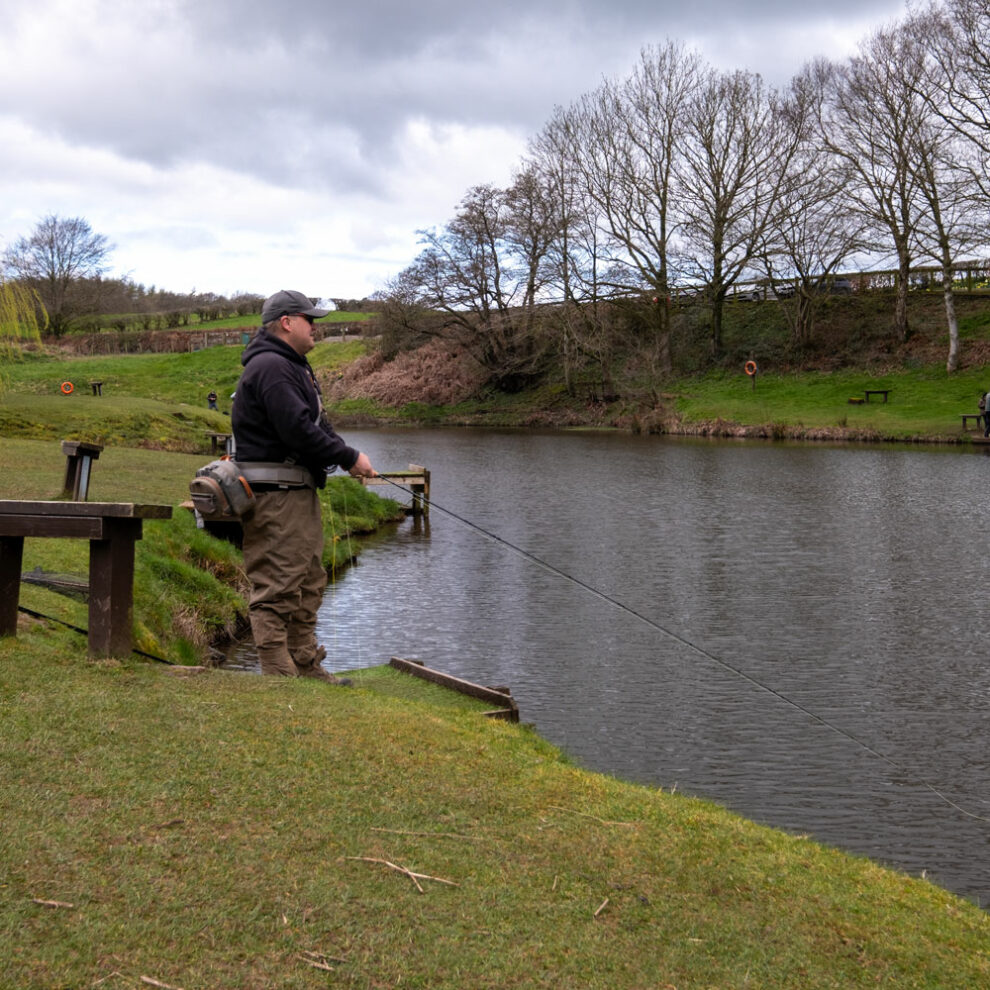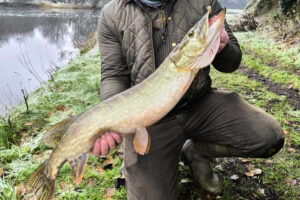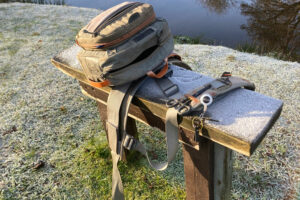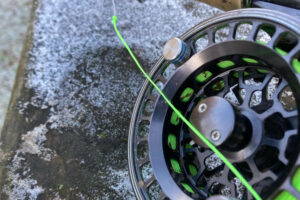Right then – you’ve put together enough kit to go on your first fly fishing trip based on these previous Beginners Blogs.
Now what?
Do you just turn up? What is expected of you, and what do you need to know to make the most of it?
Most of what follows isn’t a big deal, but going into something new can be a little daunting, so it’s nice to know what to expect.
Decide on your fishery
You will never forget your first trip, no matter how it pans out, so spend a little time researching before you make your choice.
I’m assuming we are dealing with stillwater fishing in the UK for Rainbow Trout.
There are obviously rivers to consider as well, but I’d possibly avoid those unless you know someone who fishes, or you’ve booked lessons. Same story with large reservoirs – they are all a little daunting and quite honestly, the fish could be anywhere for a complete beginner. So I would start on a small water.
These tend to be more compact, with a higher density of fish per acre and are generally only there for fishing and so are maintained to be more angler focussed.
Nothing beats fishing in the wild, but for your first trip, you may be best to keep it simple and go somewhere you know there will be fish close to you. If you enjoy it, you will end up on rivers, reservoirs or the wild lochs and loughs.
A quick online search of local trout fisheries should give you a few names. The keywords you are looking for are “day ticket trout fishery.” Some waters are members only, and you may need to pay a yearly fee just to fish. Day ticket fisheries are the simplest way to feel your way in.
Most places will have websites, which are good summaries, but perhaps the best place to look is the fishery Facebook pages.
You’re not going to go too far wrong if you find regular updates every couple of days and angler interaction. An active Facebook page can have loads of quality information hidden away in the comments and posts.
Keeping those fishery names in mind, you’d be pretty unlucky not to find a few videos on YouTube as well. These give you a great idea of what a place looks like and maybe give away a couple of hotspots to try.
Here at Cadence Fly Fishing, we have a YouTube channel under the same name where we are doing Fly Fishery Focus programmes that hopefully give all the information you need to decide where is best for you. These will show you the lakes themselves, give a quick tour of the facilities and go through a few hotspots and of course the best flies and tactics. We’ll also highlight any issues with buying tickets.
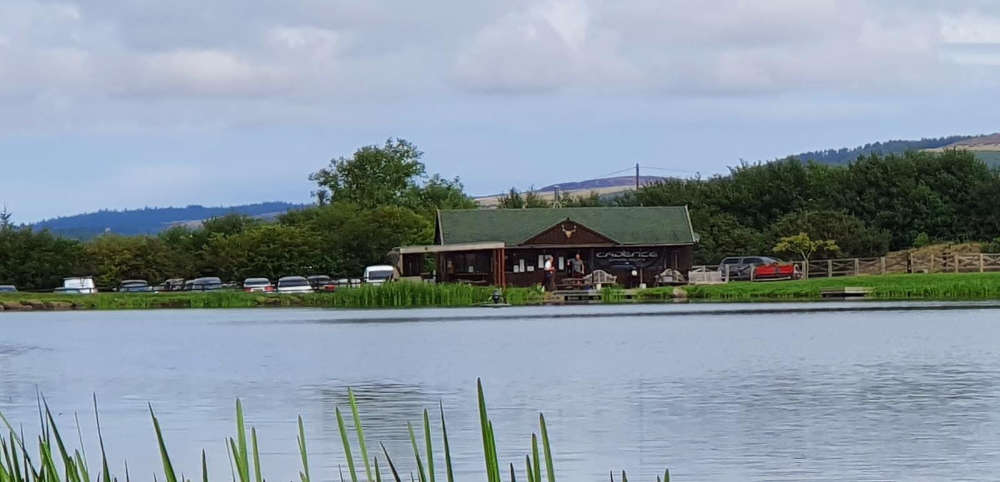
Do I need to book?
In most cases, the answer is no. The vast majority of fisheries are big enough to cope with large numbers of anglers, and you simply turn up in the car park at your leisure.
However, there are enough fisheries that insist on pre-booking, so I would look into this a couple of days before and confirm. It could save a wasted journey. If you do need to book, you might also need to give the time you want to start and finish as well.
How do I pay?
There is no exact answer and you will need to do your research.
Many places will allow all forms of payment with cash, card, or Apple/Android Pay. But there are an awful lot who may insist on cash only. Or even pre-payment online.
Some lodges have all the facilities and luxuries, some are just an honesty box with a concrete safe, envelopes, old bookies pens and a signing in book. There are lakes where you pay online the day before and can’t buy one in person on the day. These tend to be the wilder, more remote locations and are unlikely to be the small waters we are talking about.
Maybe build up a collection of pound coins and fivers just in case, but you will be OK to pay by card in over half of cases.
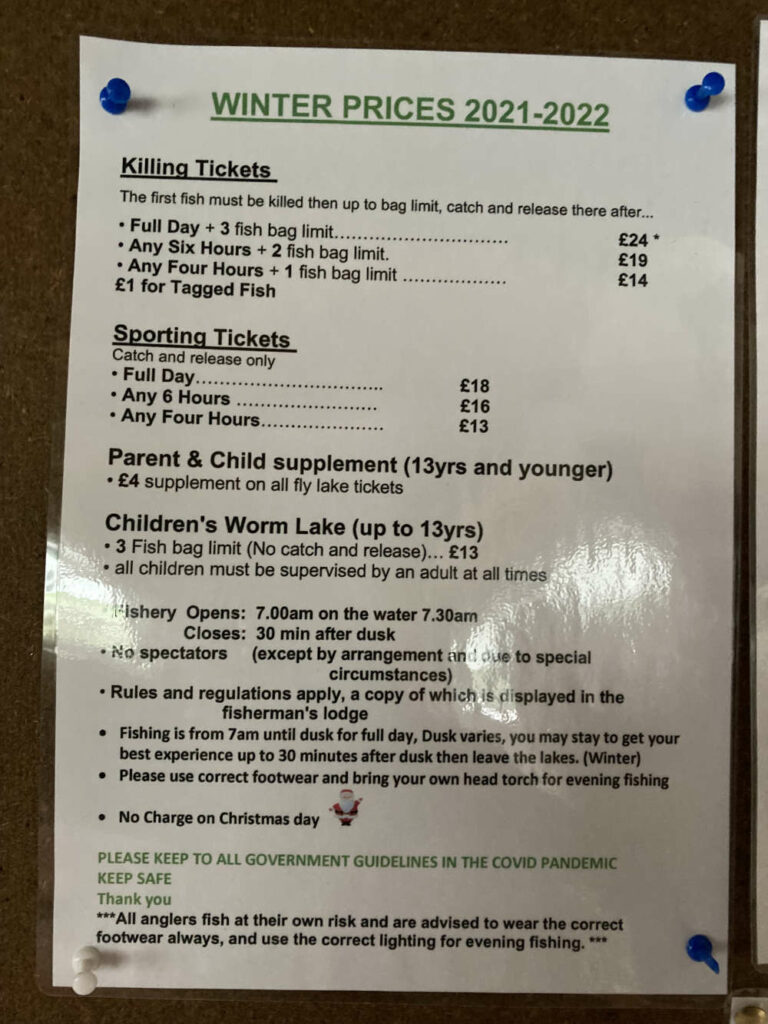
Are fisheries open all day every day?
Once again, check and make sure. Everywhere has little variations in opening times. Some are open 7 days a week over daylight hours. Some shut on regular days each week, quite often a Monday.
There are quite a lot that are only open until 5pm. Some close on dark.
One thing to keep an eye out for are fishing competitions or club bookings. These are generally notified on the Facebook page and will not be an issue if the fishery has several lakes. But if the competition is big, there are very rare times a fishery may be closed to day ticket anglers on a given day, which tends to be weekends.
The Fishery Car Park
If you go to any fishery, the car park is a great place to meet people and feel your way in. Anglers are mainly very giving souls and all you need to do is explain it’s your first trip and most will bend over backwards to help and give you a few pointers.
Look at when the fishery opens. The busiest time for car park chit-chat is half an hour before fishing starts, while people are tackling up. If your neighbouring car boot is occupied, have a chat and don’t be scared to ask questions. This invariably means you’ve chalked up someone to speak to on the bank as you move around, and you won’t feel so much of a stranger.
If you want to keep yourself to yourself and avoid the stampede, arrive an hour after opening. This will also mean you get more time with the staff on duty and be able to pick their brains on where to start and what flies to use. If there are 20 people paying for tickets, it’s more of a rush.
Stating the blindingly obvious, but the best person to speak to at any fishery is the one who is there all the time. They know where the fish are most likely to be and how they’ve adapted to the latest weather changes. So the person selling you your ticket is a great port of call for a few minutes.
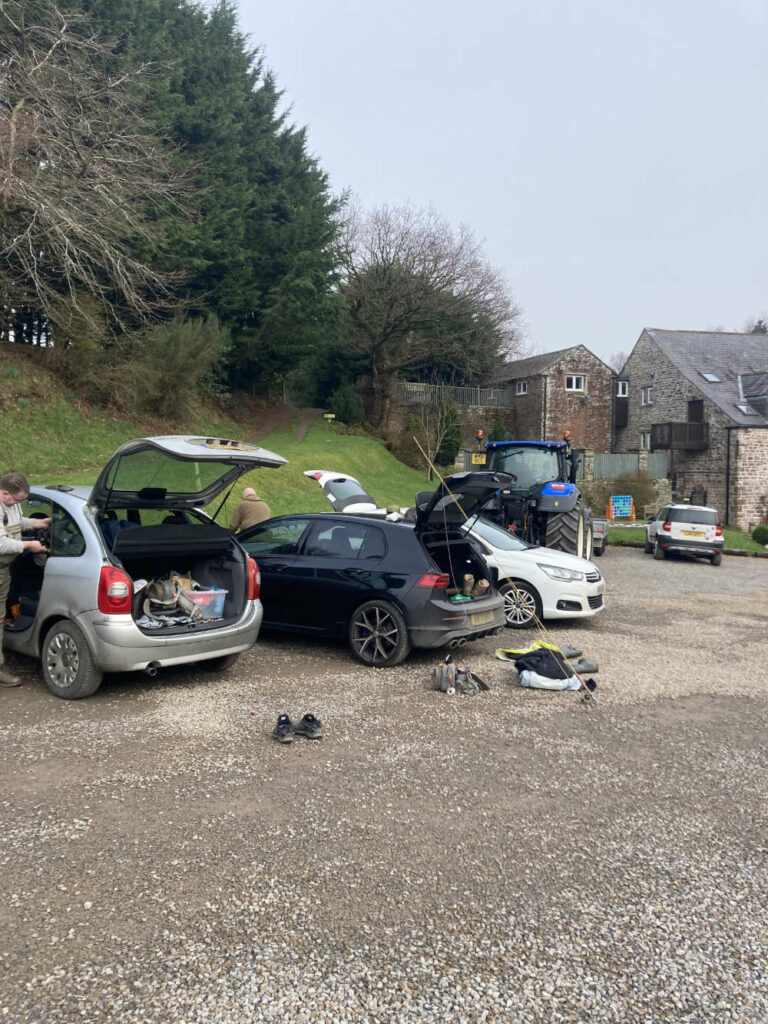
Check In, Check Out and session times
There are very few fisheries this is not necessary.
If it’s a staffed lake, you are automatically checking in when you buy your ticket from that person, and they will likely make a note of your name and ticket type or ask you to sign a book.
If the fishery is an honesty box or similar, there will be a signing in book where you must add your name to the list. Follow what the previous anglers have done, but this invariably means putting your name and session type BEFORE you start fishing.
This means that staff can check payments against bodies on the fishery as a quick check to see if anyone is sneaking on without paying.
Most signing in books will also have catch details from previous days and what flies worked. If there’s not a queue behind you, have a leaf through.
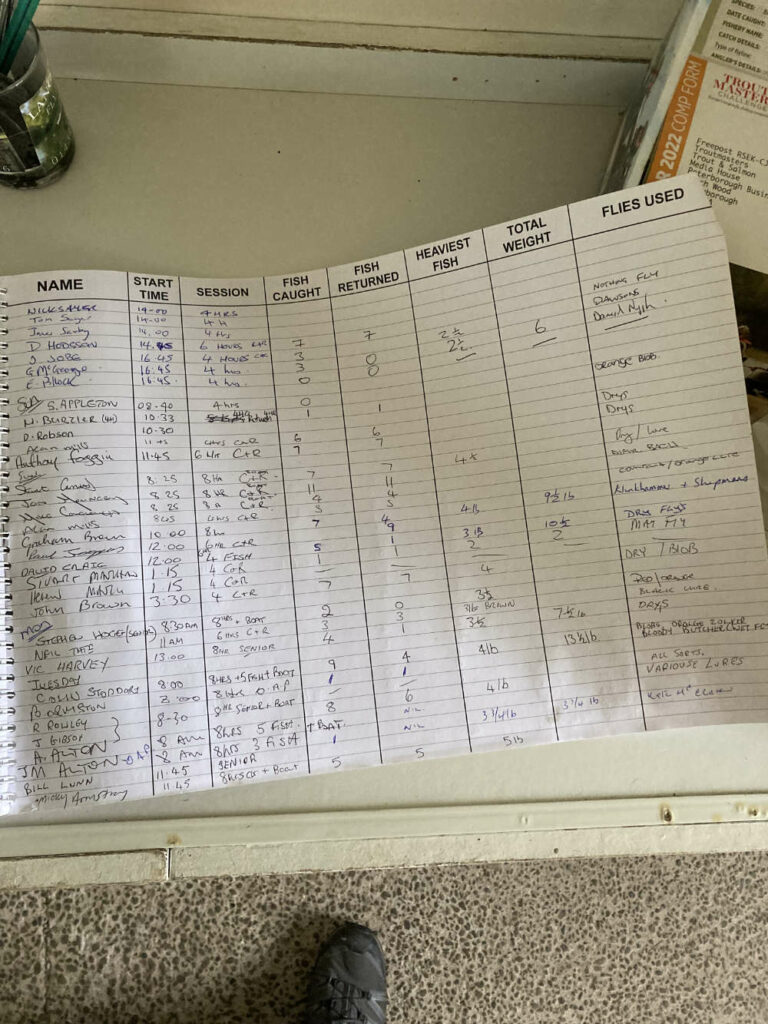
Your session type can generally be a set period of hours at any time the lakes are open. The most popular are 4, 6 or 8 hours, but there may be many other variations to choose from, such as All Day, Half Day or Evening.
All of which means you need to keep an approximate eye on the clock. There aren’t many fisheries I know who clock watch to the minute and most will give you a few minutes grace after buying your ticket, but stick to your chosen session as much as possible.
You must also check out before leaving the fishery as well. In pretty much the same way, you checked in. Fill in the missing details you started in the signing in book that morning.
It is important, so the fishery knows how many fish have been taken out — so they know what to put back in.
The numbers are important for fishery reports/rod averages and don’t forget leafing through the book at the start where you look at the previous few days catches. The next day’s anglers will want to see what was caught the day you were there.
If it’s a staffed fishery, call into the lodge on your way out and let them know. You might even get a mention in the weekly report.
The Fishing Session
Although this article is about all things outside of the actual fishing itself, your starting spot on your first day is important.
As a complete beginner, have a look at the wind direction, which is easily done by looking on the water’s surface. Your best starting point will be with the wind behind you, blowing into your back. It’ll help with casting.
For safety reasons, you should definitely consider your casting hand as well.
If you are a right-handed caster, you want the wind blowing from your left side over to the right. This means it will steer the line and hooks away from your face when casting — rather than into it. Something you will overcome further down the line, but for your first few trips it’s an absolute must. Obviously, do the opposite if you are left-handed and aim for a right to left wind.
If the wind is behind, you still want to consider if it is erring more left to right or right to left and adjust your standing position as above.
If the wind is forecast to be extremely strong, I’d suggest you cancel your first trip until it calms down. Once again, fly fishing in strong winds is completely surmountable. But not on your first day. You’d hate every minute.
And please do not forget to wear your shiny new polaroid glasses for reasons already discussed in the Essential Items blog. They stop your eyes having hooks buried in them from wayward casts. Enough said.
Advice on the fishing part of your day is far more freely available, so I’ll leave that to other articles.
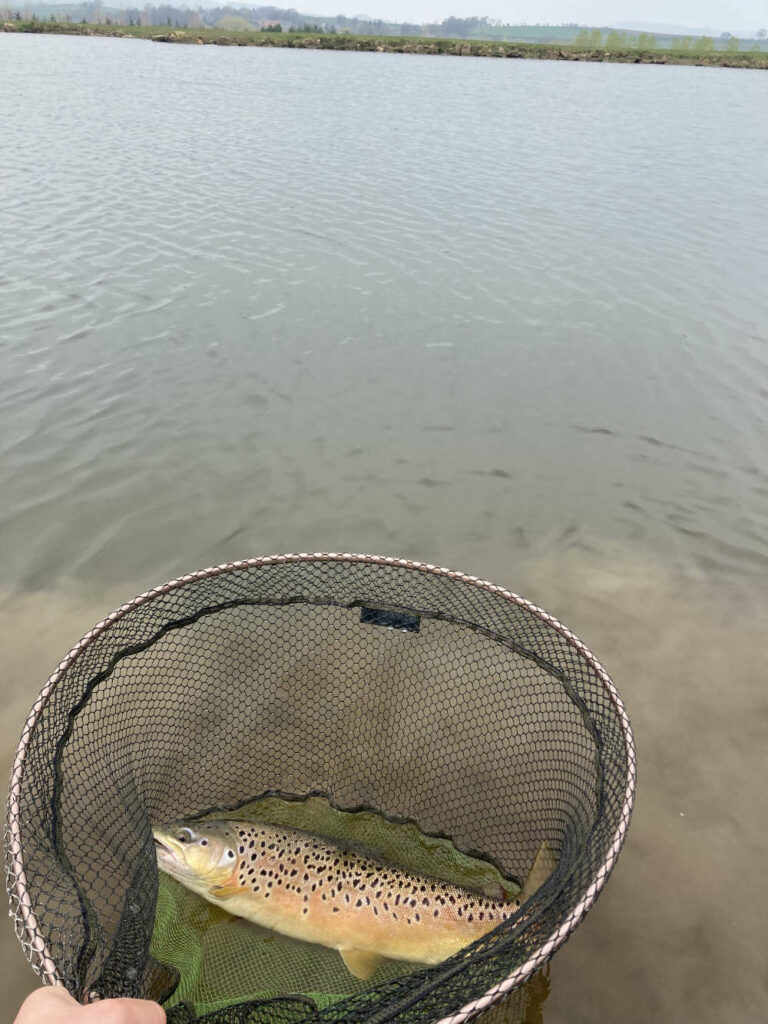
What is expected of me during my first fishing session?
This is more or less a list of what not to do’s.
Things to avoid stopping getting hacky looks or chucked off the fishery in disgrace
Handle the fish properly.
There are many things you can do wrong, but the Premier League of misdemeanours would be a lack of fish care after netting and leaving fishing line on the bank. Let’s look at handling the fish first.
First things first with unhooking and returning fish – make sure you research it fully beforehand. Go on YouTube and look at how to unhook and return fish. Understand that trout have teeth and how to overcome them.
Don’t wait until there’s a fish distressed wanting to get back in the water to find your pliers are in the car. Know what you are going to do because this is the main point beginners are caught out on nearly every time. They panic as much as the fish, and it can end up as a bit of a pantomime.
In more detail, if you are catching and then releasing a fish, don’t take it out of the water and lie it down onto the bank or platform to unhook it. Fish are fine being taken out of the water very briefly. But the damage done to a fish flapping around on gravel won’t be seen when it swims off. It’ll take a few weeks, but that fish has just been given a slow death sentence, as the door for disease has been opened once its protective slime layer has been broken.
Keep the fish in the net with the net in or above the water at all times. If you have to touch the fish, make sure your hands are wet. Try to avoid handling where possible. Assuming you are returning the fish, the priority is to take the hook out. As it should be barbless, it should slide out easily if it hasn’t dropped out in the net after landing. You may need forceps/pliers to reach just inside the mouth (see teeth reference).
Most small water fisheries insist on barbless hooks only. Using barbed hooks will have you thrown off in a heartbeat. The best way to avoid accidental use is just buy barbless flies from the start anyway. But if you do have barbed, make sure they are completely flattened by pressing the barb down with pliers.
Once the fish is unhooked, check it can support its own weight and ideally burrowing around trying to find a way out of the net. These fish can be released straight away.
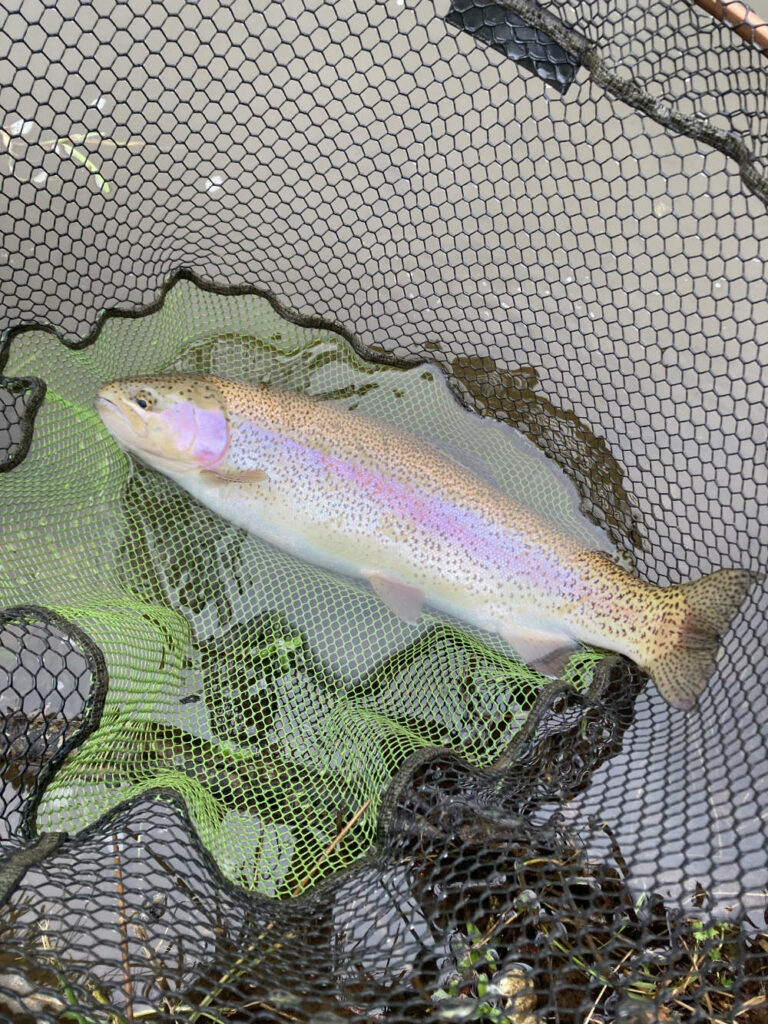
Occasionally, you will get one that is out of puff and requires a minute to get its breath back. It may be lying on its side or occasionally go upside down, so keep propping it back up using the net and water to reposition it. I want to say stand it up even though it’s a fish – I’m sure you get the idea. This may take a minute or two.
Eventually, it should start to move around more freely, at which point you can lower the net and let it swim over the rim.
Very occasionally you may get a fish that can’t be pulled around. It is very rare, but if this happens, you need to kill it. Even if you are on a catch and release only ticket.
It is unfair to put a fish that is struggling back, so knock it on the head and go straight to the lodge to explain the situation. If no-one is there, post a note in the honesty box and offer to square up. Most fisheries will understand and most likely let you take the fish home without payment. The main thing is the fish is put out of its misery straight away.
On the subject of which, you should have a priest immediately to hand at all times. Not the churchy one, but a tool to administer the last rights — which is I think where the name comes from. It’s a stick with a heavy weight on the end anyway.
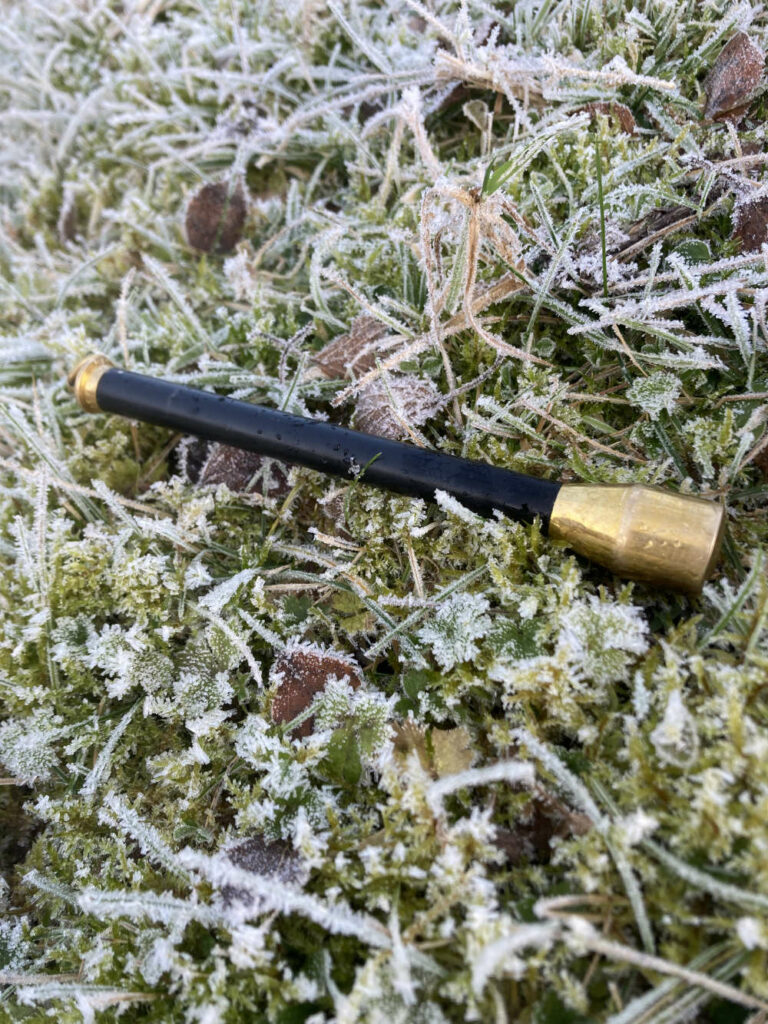
Once again, do your research with YouTube videos, but in essence you will need to bring the fish onto dry land for this. We don’t need to worry about long-term effects of handling if the fish will be eaten and therefore killed.
It’s best to keep the fish in the net here, or it could flip away. And you need to be decisive and not fanny around. Grip the fish firmly about half way down the body and keep it held, so its belly is touching the ground. So you are lightly pressing down. With your free hand, use the priest to hit it just above and slightly back from the eyes on the top of the head. Don’t hit it on the nose. And don’t tap it. There’s no point flowering this up, but give it a good smack and that should be that. Go for a second one to be certain.
We also mustn’t forget that this is your first fishing trip, and you might want a photo of your first fish. The main thing here is to keep the fish in the net in the water as much as possible. Have your camera to hand and ready to go. Ideally, you will be OK with a photo of the fish lying in the net, so gently lift the net an inch above the water and snap.
If you want to be in the photo, the fish should only be lifted above the water for a few seconds with wet hands. DO NOT lift the fish up and stand over dry land with it.
Trout are very slippery things and once they go into beast mode you aren’t holding on to them. Which is why crouching or kneeling next to the water is best. You avoid dropping the fish from a standing position if it does wriggle free and its fall is only a few inches into the water, which harms nobody.
Now we’ve avoided the fishery manager running down the bank with a gun because there aren’t fish jumping around on dry land with a barbed hook in them, we can move onto the briefer things to avoid.
Used Fishing Line and litter
Litter is a lot of folk’s pet hate, and most fisheries will have bins dotted around them. Even if they don’t, it remains your responsibility not to leave any, as in all walks of life.
An empty sarnie wrapper is bad enough, but you’re into hanging offence territory if you leave fishing line on the bank. It may not seem it, but discarded line is absolutely terminal for bird life. They get completely tangled up in it and it’s an horrific sight. Take your used line home and cut it up into two inch pieces before binning it. This offence would probably be number one or two on most anglers hate lists, but some people still do it. If you see any lying around that isn’t yours, pick it up as well.
Don’t Push In
Anglers can get territorial, so don’t fish too close to someone else unless invited. It does happen, especially when fish are being caught in a specific area. People will migrate towards someone who is catching regularly, but there can often be one who takes it too far and gets too close. Don’t be that person and try to fish at least 15–20 yards away as a minimum.
Changing Places
If you are moving spots and need to walk behind another angler, wait until they’ve done their latest cast before going by. If hoods are involved, it’s likely they won’t even know you are there, and you run the risk of getting a hook in the face. If they do know you are there, it’s a generally accepted unwritten rule that you wait until either they’ve cast or they’ve said it’s OK for you to go past.
Stopping for a chat?
If you want to talk to someone for longer than a couple of seconds, look at what hand they cast with. If it’s right-handed, go and stand next to their left shoulder and vice versa. The safest place to stand while someone is fly fishing is next to their non casting shoulder. This means they don’t need to stop fishing while talking.
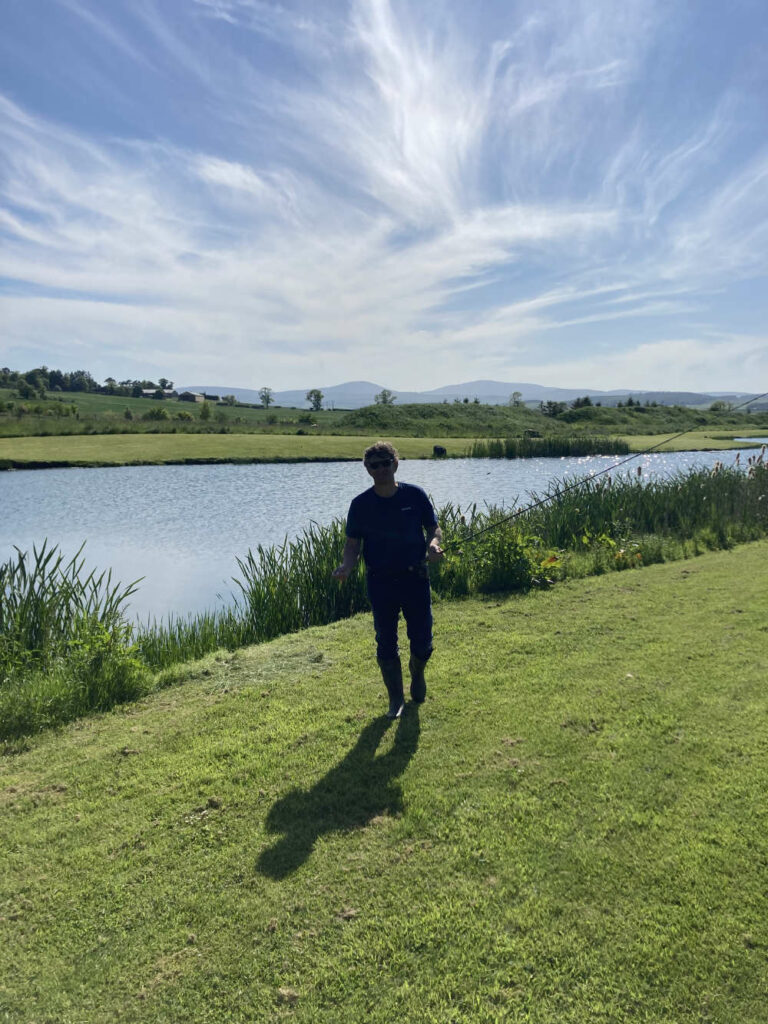
Landing Net
For fly fishing on small stillwaters in the UK, you will absolutely need a net. It’s the intermediate step between hooking a fish and dealing with it. It’s also the finish line for classing the fish as caught. If it gets off before it’s netted, I’m afraid it doesn’t count.
Many fisheries supply all landing nets, some will need you to take your own. (See non-essentials blog about nets). Either way, a landing net is a must.
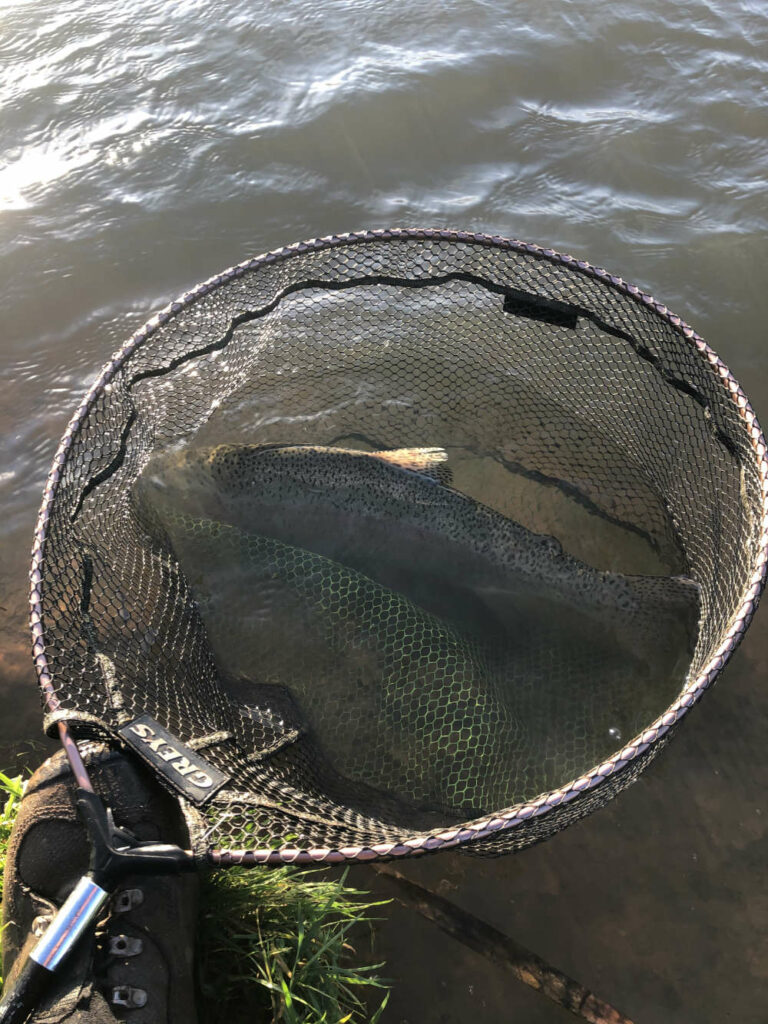
Fishery Rules
Read up on the rules particular to that fishery before you fish. They can vary a little bit. Some may ask you to fish in a spot no longer than two hours. Some may tell you if there are no-fishing zones or what the minimum breaking strain of your leader must be. Either way, don’t say you didn’t know, as it is your responsibility to read them before fishing. It will be assumed you have if you buy a ticket. The rules will be displayed at the fishery and most will be online as well.
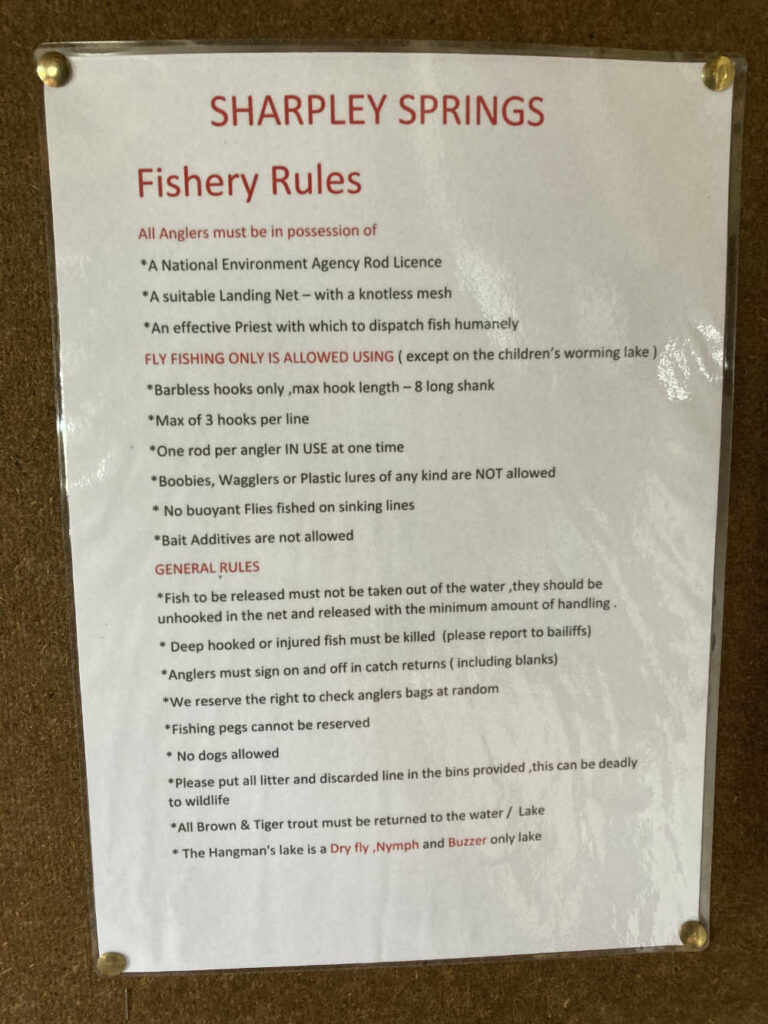
Tuition
I’ve written this series on the assumption that you are going solo on all of this, and hopefully, it’s given you something to think about before you take the leap. Go into it with half an idea of what’s coming, and you’ll find it far more enjoyable. Fly-fishing is an incredible hobby to have and will give you years of enjoyment.
You can skip all three of these blogs and just go straight into a Guided Day with an instructor. It saves buying anything, and you have someone to steer you in the right direction and save going the long way around making mistakes.
This is something I do myself, and while everyone who teaches will have a slightly different take on how to do it, it’s generally money well spent. It can fast-forward you to a decent level way quicker than you would just reading about it.
If you want to discuss a day, I am based in the North East of England and will be happy to answer any questions on how you may want to structure your day. It’s all very flexible to suit. Email me at stuart.ingledew@cadencefishing.co.uk or join Stuart Ingledew Fly Fishing on Facebook.
If you are based elsewhere, ask your local fishery for whom they recommend. Most will have a preferred list of Guides/Instructors who teach on their fishery regularly.
As a very rough guide to what you should expect from a guided day, the first thing is most will supply the tackle as part of the day’s fee. You would only need clothing to suit the weather and a pair of glasses.
For myself, I would include every bit of tackle from the rods and reels down to the flies and floatants at no extra cost.
You would have someone stood on your shoulder for the duration who could net, unhook and return the fish if that was something you were unsure of. But most of all, someone to put you right on where you are going wrong at all times. It’s a perfect way to introduce yourself to fly-fishing if you don’t want the hassle of buying a load of stuff and reading all these godforsaken blogs on how to get started.
Hope to see you on the bank soon.
